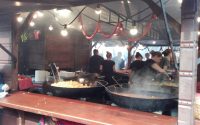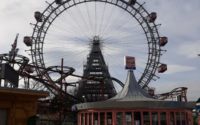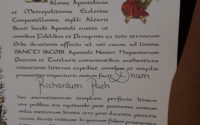Warsaw – The Phoenix City
If you have seen the award winning film ‘The Pianist’, you will get an idea of the condition of Warsaw at the conclusion of WW2; a city totally ruined, almost completely flattened on the specific orders of Adolf Hitler. Warsaw truly is a phoenix city. In this respect it has a twin in Berlin, a city also flattened by the actions of Hitler.
15.09.2017
I can hardly remember anything of Warsaw, but I can see it has changed massively from when I was here before, so it’s worth taking a look, even though I don’t think I have any heritage to be found here, but you never know. My father, to my knowledge never visited Warsaw when he lived in Poland. The only other tentative connection, is that ,my grandfather was in action during what the Poles call ‘The Miracle of the Vistula’, when in 1920,during the Polish-Bolshevik War they repelled and defeated a much more powerful Red Army unit. Through sheer irony, after WW2, Stalin’s gift to the Polish nation was the Palace of Culture and Science, which also happens to be the tallest building in Warsaw. The response that the citizens of Warsaw made to tourists who would ask where they could get the best view of Warsaw, was to climb to the top of the Palace of Culture and Science because from there you could not see Palace of Culture and Science!

The hotel Hetman is located in an area called Praga which has in the past carried a questionable reputation. I had not realised this, when accommodation near the Old City. Concerned? A bit, so out comes the laptop – glad now I brought it as it eased me a bit. The north section of Praga, which is a large area, is the one which still has a dodgy reputation. The south part, where I am, has had a makeover allowing trendy businesses and artists to move in.
Walking down the Aleja Solidarność (they appear in every town and city as you might expect) and over the Śląsko-Dąbrowski Bridge which crosses the wide Vistula, if you pause for a moment and look in all directions, you become aware of how massive Warsaw is. There are cities with larger populations than Warsaw, but I think if you researched you would discover that they had less of an area than Warsaw.
A travel pass is a must for this city, and having bought one, a tour round the Old City. This was once the poor area of the city which had fallen into neglect. Renovation began before the war, and then it was destroyed during the war. Poland began again with a reconstruction in the late 1940’s, helped largely by willing volunteer citizens and the work is now largely completed. Just a few renovations to go. It is a must do for any visitor to Warsaw.

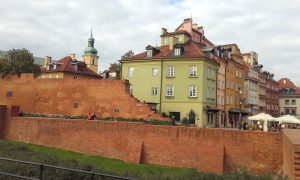
16.09.2017
The Jewish people were, for centuries, such an essential component of Polish life and I would like to explore what I can on the ground. There is only one synagogue left in Warsaw out of hundreds that once existed, and thankfully it is in use today and beginning to thrive once more. The Nazis used it as a warehouse. I spoke to one of the elders of the synagogue and although I cannot get in today as it is Shabbat, I’m welcome to look around another day. I shake my head when he says there used to be around 300, but then in typical fashion he says ‘at least they left us one.’ Remarkable sense of black humour. Not only practicing Jews but anyone of Jewish descent whether or not they are Jews today is welcome to pray there.
Not far from the synagogue, stands the only remaining fragment of the wall that enclosed the Ghetto. Europe lost so much of it’s soul with the Shoah (Holocaust) especially here in Warsaw where 33% of the population was of Jewish origin whether practicing or not.
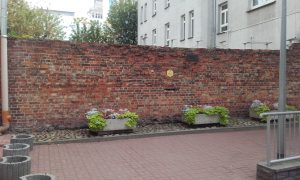
This stage of my time in Poland, will be more as a tourist as I don’t think any of my forebears were connected to Warsaw.
The streets are wide; it’s not a city that squeezes you. The streets from the centre to the Old City, especially Krakowskie Przedmieście are mainly pedestrianised or in the process of becoming so. This street approaches the Old City and government offices, churches, street theatre, interesting shops, the University of Warsaw and the Presidential Palace all share space on this long and wide boulevard. It’s difficult to believe the city was a ruin just over 70 years ago.
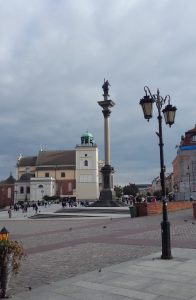
Quite unexpectedly I arrive at Poland’s War Memorial and every campaign that was ever fought, dating back to the Middle Ages is inscribed in stone. There is a small ceremony taking place with some uniformed soldiers and it transpires that as today is the 16th September, some veterans are laying a wreath to commemorate the Soviet invasion of Poland in 1939. I do not imagine this was possible prior to 1990.
The Museum of the Polish Army stands across the square from the War Memorial and there are some old photographs on display. It strikes me that I should look inside when it’s open next and see if there are any pictures of my grandfather. As a final thought, I’ve just discovered that an archive building I’ve been referred to as maybe having information about the possible whereabouts of my father’s birth certificate, is in the same street I’m staying. Amazing coincidence!
17.09.2017
The Polish Army Museum; outside lie rusting hulks of old Russian tanks, military aircraft and other pieces of ordnance. I’m really not interested in any of this stuff except for one Russian WW2 tank. It looks like it was put together in under one hour. You imagine from the old war film footage that the tanks are all brightly polished. Its armour is so rough you could cut your finger on it. I suppose all the situation demanded to mass produce these things were tracks, and a big gun at the front. The Russians had to produce these tanks faster than the Germans could knock them out.
Inside the Museum, it would be quite an occasion if I discovered a photograph of my grandfather. I quickly skip past all the swords, armour and anything else before the late 19th century. What is interesting is the number of paintings by officers and men in the prisoner of war camps and there are photographs of Oflag VII Murnau, where my grandfather was incarcerated after capture. Unfortunately none either depict or feature him. From what I can see it looks as if the German captors pretty much let them do as they pleased – except build tunnels. I was however able to photograph what would have been his uniform and a representation of the Virtuti Militari.
Having spent all that time on Babbel’s Polish language course, I get tongue-tied with the language and much of speaking it escapes me, the words that I know don’t come out even though I can get the gist of what is being said. I’ll need to spend more time talking to Poles at home. Problem is that they want to speak English all the time.
On the eating side, I order as much genuinely Polish dishes as I can. Tomorrow I’d like to try Jewish contribution to Polish cooking.
18.09.2017
I don’t expect anything much from my visit to the State Civic Registration Office. I have written down in Polish (via Google translator of course) the important details to avoid sign language, grunts and doodles.
The enquiry has generated a bit of interest; thank goodness I wrote that down, however and as I had imagined the chances of me finding the birth certificate in Poland are next to zero, unless some person smuggled it out. I had already resigned myself to that, so in the end I did not leave the office disappointed. The staff member explained that in Poland birth registration, unlike UK, is categorised by religion and is recorded in ‘metricals’ as they are known as. This applied throughout the Austro-Hungarian Empire of which Lwów and Przemyślany were a part. It was a Polish practice before the partitions of the late 18th century and it just so happened that the Austrians did the same. I would need to find where the Roman Catholic or Armenian Church ‘metricals’ for Przemyślany are now stored. As Przemyślany was incorporated into the USSR; more specifically Ukraine; the Soviet authorities (state security NKVD) in 1945, would not have permitted these metrical books to return to Poland. The NKVD needed all the information they could about potential enemies of the state. Unlike Poland, Ukraine has no Civic Registration authority that can deal directly with enquiries like mine. I explained that I had been to Lviv and someone there had made enquiries on my behalf without success. The staff here are not surprised at this as the system in Ukraine is chaotic as they have metricals not only from Poland, but also Hungary, Romania the former Czechoslovakia and Belarus, all of which ceded territory to the USSR and to Ukraine in particular. The Soviets were unconcerned with matters like this and since Ukraine became independent, it has been trying to make order of this mess. My best course of action it seems, and it is only speculation, is to contact the Ukrainian Ministry of Justice as a start or to contact the Ukrainian Embassy in London and explain the fully and see what it can suggest. I think it’s best to pause for now and decide what’s best with the options we have, rather than sending letters all over the place.
The synagogue I am re-visiting, The Nożyk Synagogue, is the only one of 400 that existed in 1939 left in Warsaw. Built between 1898-1902 and financed by Zalman a merchant and his wife Ryfka Nożyk. It was renovated and completed in 1983. This is my first ever visit to a synagogue and I’m wearing a yarmulka on my head, as a mark of respect. The synagogue has a simple and rather functional layout. The part we would call the altar is the Ark or Aron-ha-Kodesh where the Torah scrolls are kept behind a curtain called a parokhet. The podium in front where the rabbi or cantor reads the scrolls is called a Bimah. Standing here, it is impossible to comprehend the scale of the tragedy over a period of just six years. A short space of time but to Jews, Armageddon had arrived. It is hard not to feel a sense of collective shame for the way Europe has treated its Jewish citizens either through silent or vocal anti-semitism down to the outright destruction of the Nazi era. A chunk of Europe’s culture was lost. For some innate reason, I feel a personal sense of loss.
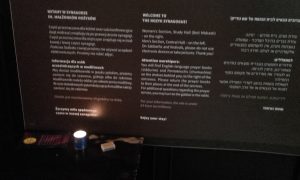
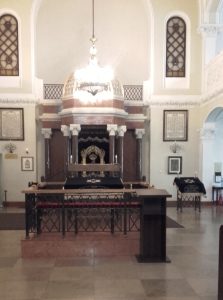
Walking down Nowy Świat, I’m handed a leaflet advertising a restaurant called ‘Zapiecek’ which specialises in Polish cuisine. As I read the menu, I’m stumped because I like the look and sound of everything I see. I go for placki ziemniaczane which is potato pancake (which tasted like the one’s my father used to make) with pork goulash, vegetables, tomatoes and sour cream and alongside that a cup of żurek which is rye soup cooked with sourdough and other goodies I can’t remember. Marvellous. It is good that the Poles have promoted their cuisine and the local produce attracts more international customers that the Oriental, Italian, French or Spanish and it is not expensive. In fact it is the best value for money I had in a long time in a capital city. This is something that distinguishes it from Berlin which seems not to advertise German produce. Should anyone ask for a recommendation of where to eat out at a reasonable cost in Warsaw, ‘Zapiecek’ gets my vote.
19.09.2017
Palace grounds to walk round, interesting museums to browse, pierogi (akin to ravioli but stuffed with a selection of either savoury or sweet fillings) to eat – no time to lose!
The Warsaw Pass entitles you to free travel on the ‘hop on hop off’ bus. As I wait for the bus there are a couple of English ladies waiting too. It is their first visit to Poland which they are enjoying. They feel embarrassment at being British in light of Brexit which they strongly oppose. One says and I agree, that patriotic Britishness is one of co-operation and being immersed in Europe and being proud of the traditional British value of integration. I would have liked to visit the POLIN Museum of the History of Polish Jews and I get off the tour bus, but it’s closed on Tuesdays. Almost all museums in Warsaw close on Mondays; just my luck this one closes Tuesdays. Ah well.
Maybe I’ve been to the Łażenki Palace, which was the summer residence of the Kings of Poland before when I was 18; I just can’t remember. I’m not disappointed with what I see. The Palace is set in several hectares of parkland, crisscrossed with pathways. The Palace itself is built over a small lake. Dating from the 17th century when Poland was at the height of its power. The expression ‘pride comes before a fall’ is appropriate here as towards the end of its construction, Poland was a weakened state as partition not too many years ahead. It is a lavish building smacking of royalty with its intricate plasterwork and gold-leafing.
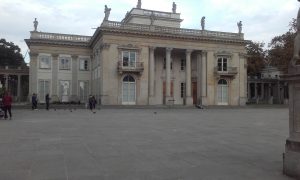
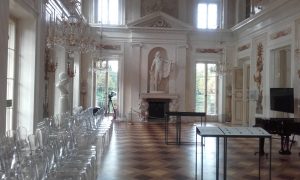
Walking around the parkland is relaxing as there are numerous established trees both deciduous and evergreens and red squirrels scurry around.
As I leave, I have a discussion with a Pole who has lived in Sweden for the last 50 years. Without any prior knowledge that I was a native English speaker he launches in perfect English. How did he know that? Our topics range from the reason for my visit here, to the refugee situation, religious and political extremism, modern Poland and inevitably Brexit. He is amazed at the effort I put into finding my grandfather’s grave. For all I know he was making it up but,he said that my outlook is typically Polish in that I want to learn from tragic history not wallow in the glorification of victimhood or the triumphalism of the victor. He introduces himself as Sigismund (I forget the surname) newly retired and had done much business in England and how friends and contacts there are unanimously against Brexit. Out of the blue he says with great conviction that I should go to Gdynia – that I would like it there. We wish each other well as we go our separate ways. What do I make of that?
For the final evening meal in Warsaw I can’t resist another visit to Zapiecek, a different one of the five in Warsaw. It has to be pierogi, particularly as they roll the dough themselves. I wonder if it is solely located in Warsaw as I didn’t see any in Gdańsk. Another very appetising meal.
I’ve enjoyed Warsaw more than I expected. It is more highly developed than I had imagined and yet it has retained its Polishness.
End
